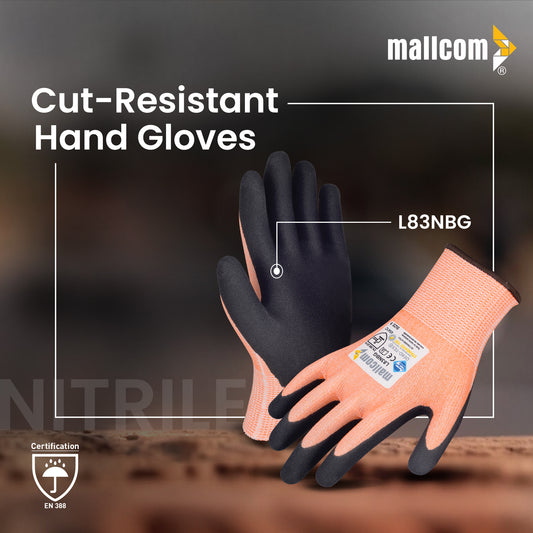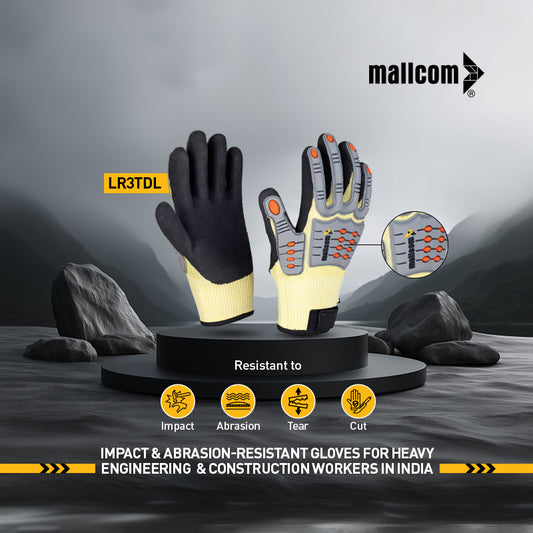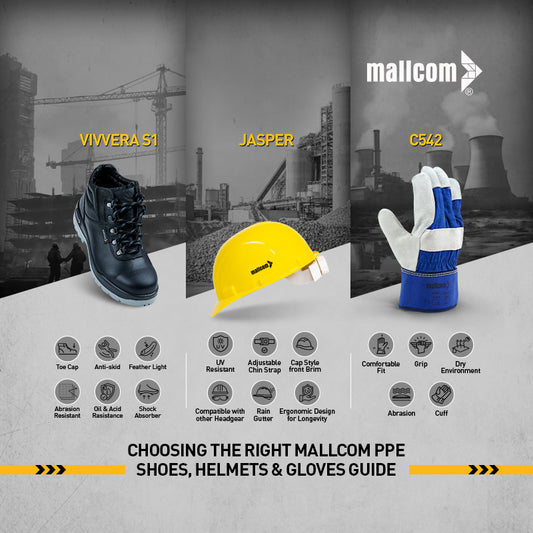In operation for the last forty years, Mallcom has succeeded in contributing heavily to the safety narrative in India. Since its inception in 1983, Mallcom has been manufacturing and distributing PPE across 50+ countries with more than 1000 SKUs. Today, Mallcom houses numerous categories of safety gloves that are tailored to meet diverse needs across various industries.
The evolution of safety protocols in industrial settings demonstrates a significant positive change, moving from rudimentary or non-existent measures in the past to sophisticated, proactive, and technology-driven approaches in the modern era. This shift has led to a notable reduction in workplace accidents and fatalities. However, was it always the same? Let’s find out.
Historical Context Behind Previously Inferior Safety Protocols
Industrial Revolution Era:
The early industrial period was characterised by extremely hazardous working conditions. Factories lacked safety regulations, and workers, including children, often toiled for long hours with unsafe machinery, often exposing them to overcrowded or unventilated environments.
High Accident Rates:
Accidents and injuries were once alarmingly common. Occupational diseases were widespread and often fatal. As per the U.S. department of labor, the U.S. recorded nearly 14,000 worker deaths each year in the 1960s. Also, around 2.2 million workers were out of work due to injuries and illnesses. The early 20th century was even worse. In 1900, for example, about 300 out of every 100,000 miners died each year, according to a study by the National Institutes of Health. Today, that number has dropped to around nine per 100,000. The progress is significant, but the past reminds us why safety must never be compromised.
Positive Change in the New Era
Modern safety protocols have brought a major shift. They are no longer reactive; they are proactive and preventive.
Stronger Laws and Standards
The new era has introduced robust global safety laws. India implemented the Factories Act in 1948. The United States followed with OSHA in 1970. Later came international standards like OHSAS 18001 in 2007. This was succeeded by ISO 45001 in 2018. Each framework pushes employers to manage risks systematically. They also stress the employer’s duty to ensure worker safety.
Proactive Thinking at the Core
Today, the focus is on preventing accidents before they happen. Hazards are identified early, and risks are assessed in advance. ISO 45001 sets clear guidelines for this proactive approach. ISO 45003, introduced in 2021, goes a step further. It helps employers address mental and emotional well-being at work.
The New Era Is In Safe Hands
From Canadian, Driver Gloves to Seamless as well as Cut-n-sewn Nitrile Gloves, Mallcom has been the main leader in India that has improved the standards in terms of features, tech innovation, certification and categories. These are in line with Indian (BIS/ISO) to global certifications (EN, SEDEX, AUSTRALIAN, etc). Stringent tests are performed on all these products to ensure that the new era eradicates or cushions against the likelihood of unforeseen fatal events.
Let’s look at some of the key features of modern-day safety gloves and how they compare to the technology of yesteryears.
Filament Steel Blended Para-Aramid Lining: The Modern-Day Shield
What it does:
Combines the strength of steel fibers with the heat and cut resistance of para-aramid (like Kevlar). This hybrid lining offers exceptional cut resistance without compromising on dexterity.
Why it matters today:
Modern industries involve sharp tools, sheet metal, heavy machinery, and high-speed fabrication. This lining ensures that workers in automotive, metal, or heavy fabrication units get cut-level protection (EN 388 - 3542F) without the bulk of older, rigid gloves.
Elasticised Back: A New-Age Fit for Dynamic Work
What it does:
Provides a custom-fit around the wrist, improving comfort and reducing slippage.
Why it matters today:
In fast-paced environments, quick donning and a secure grip help reduce delays and mishaps, especially for field engineers or transport handlers. This wasn’t possible with older open-back glove designs that were loose and ill-fitting.
| Feature | Old Era Limitation | Modern Upgrade Advantage |
| Basic leather with no lining | Poor cut resistance, bulky fit | Steel-aramid lining adds cut + heat protection |
| Loose cuffs | Poor grip, safety hazards | Elasticised back ensures a secure and snug fit |
| No reinforcement on seams | Fraying and quick wear | Synthetic tape boosts glove lifespan |
| Stiff, non-flexible material | Reduced dexterity | Natural grain allows freedom of movement |
Reinforced Natural Split Leather: Built for Brutal Environments
What it does:
Uses natural split leather with extra reinforcement at the palm, the most contact-heavy area. Offers superior abrasion resistance, puncture protection, and durability under extreme heat or mechanical stress.
Why it matters today:
Modern welding isn’t limited to fixed stations — it includes mobile welding, structural steelwork, pipeline jobs, and automated welding arms. These environments are tough on gloves. Reinforced palms give welders the confidence to handle hot parts, sharp edges, and rough surfaces without the glove wearing out prematurely.
Vein Protection: Safety by Design
What it does:
Incorporates a design contour or padding to cover the radial and ulnar veins — key blood vessels in your wrist.
Why it matters today:
Even minor lacerations or burns on the wrist can be life-threatening. In environments like oil & gas welding, shipyards, or refineries, this design prevents catastrophic injury from flying sparks, metal burrs, or tool slips.
Heat Resistance up to 250°C for 15 Seconds: Time to React
What it does:
Allows safe contact with heated surfaces up to 250°C for short durations — enough time to drop a part, adjust a tool, or move away from danger.
Why it matters today:
Modern welding workflows are fast-paced. Whether you’re changing torch heads, handling welded parts, or working in thermal maintenance zones, these gloves give you a critical reaction window. Traditional leather gloves would burn or shrink under such heat.
| Feature | Old-Era Glove Limitation | Modern Upgrade Advantage |
| Plain leather with no palm pad | Quick wear-out on the dominant hand | Reinforced palm = longer glove life, better safety |
| Short cuff or knit wrist | Forearm exposed to sparks | 7 cm cuff gives forearm-level protection |
| No vein coverage | Risk of injury at exposed artery points | Built-in vein protection reduces critical injuries |
| Poor heat tolerance | Burns within seconds | 250°C for 15s gives time to respond to contact |
Securing the Future, One Glove at a Time
The journey from crude, reactive safety protocols to proactive, precision-engineered solutions reflects how far we have come and how vital the right protection remains in shaping the future of industrial work. Mallcom’s relentless focus on research, certification, and innovation has positioned it as not just a manufacturer but a catalyst in India’s safety evolution. Whether it is with steel-blended para-aramid linings, heat shielding reinforced leather, or vein-conscious ergonomic designs, Mallcom gloves are a testament to what the new era demands - protection without compromise and performance without hesitation.
As industries evolve, risks may change. But with Mallcom, the hands that build our world are always in safe hands.








